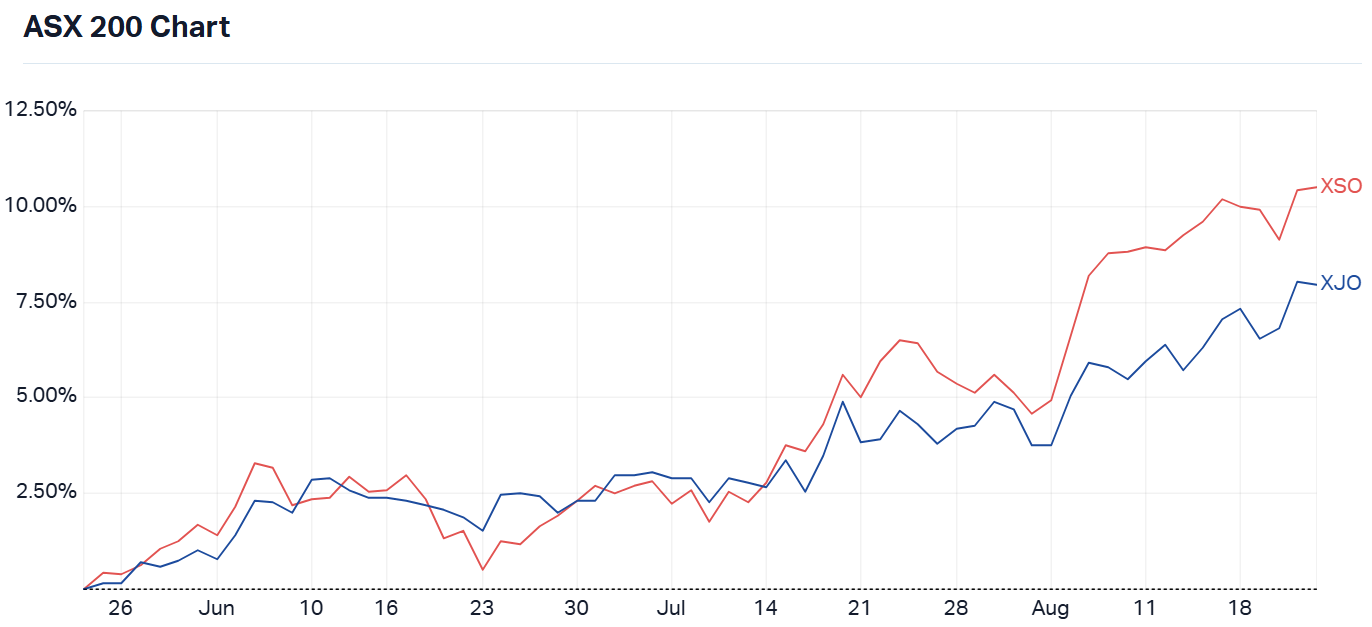Small caps surge 5.6% in August - Nick Guidera on what's moving beneath the surface
In August, the ASX200 has climbed 4.1%, rising from 8,662 to 9,019. The Small Ordinaries have done even better, adding 5.6% from 3,320 to 3,506. That leaves small caps ahead by 1.5 percentage points for the month.
It’s not just a one-month story. Over the past three months, the ASX200 is up 7.6% (8,386 to 9,019), while the Small Ords have surged 10.6% (3,169 to 3,506). On that measure, small caps have outperformed by a healthy 3% - showing renewed strength at the smaller end of the market.

It's against this backdrop that transition points matter most, those moments when a company shifts gear, or a market theme begins to take shape, as well as the thrill of discovering what others may have overlooked. For Nick Guidera of Eley Griffiths, that's what small-cap investing is all about.
It’s a perspective honed across more than a decade in financial markets, first as a lawyer, then through years at global research house CLSA in both the U.S. and Australia, before joining Eley Griffiths Group in 2016.
Today, as Portfolio Manager, Guidera brings more than 12 years of experience to the small caps space, a corner of the market he relishes for its dynamism and constant change. In this week’s conversation, Guidera shares the thinking behind his most recent moves.
For investors, Guidera’s perspective offers a valuable lens into where opportunities may lie. The resilience of infrastructure, the cyclicality of consumer spending, and the untapped potential of innovative businesses navigating short-term headwinds.
In a market that rewards those who look beyond the noise, his approach underscores the importance of curiosity, discipline, and backing management teams with the vision to build something sustainable and enduring.
While Guidera admits to some frustrations, such as missing out on the resurgence in mining services, he remains focused on uncovering the next opportunity. After all, in small caps, the payoff comes from spotting the inflection point before the market does.
.jpg)
What’s your most recent investment and why?
I recently added a small position in Channel Infrastructure (NZE: CHI), the owner and operator of New Zealand’s largest fuel import terminal at Marsden Point, responsible for the storage and distribution of 80% of NZ jet fuel.
The company has been on a transition from refiner to infrastructure asset owner with the establishment of the critical Energy Precinct.
In a market where infrastructure assets are rare, particularly ones that have embedded growth in the footprint, and some leverage to NZ as a destination of choice for global tourism, Channel Infrastructure stands out.
Currently Kiwi listed, the company announced in May that they will consider dual listing on the ASX in the coming months, which could open the door to another group of potential investors.
Which investment did you add to your watchlist this week?
Audinate (ASX: AD8) – the stock fell 20% on results day on the back of disappointing Gross Profit guidance and plans to grow opex by 25%, resulting in future earnings downgrades. The stock is now down ~80% from its highs reached in March 2024.
The business has the largest position globally in AV networking and continues to add new design wins.
While the near-term growth outlook is patchy, and cyclical headwinds are impacting the core, the business doesn’t appear to be broken.
What is the most recent investment you have trimmed or sold, and what drove this decision?
We have been trimming our position in Temple & Webster (ASX: TPW) in the last couple of months, as the stock has continued to rerate on the back of an improving consumer backdrop, and investors seeking quality, structural growth names.
While we are long-term believers in management and their goal to be the largest furniture & homewares retailer, we have owned the stock since April 2019, and since its ASX 200 inclusion, we have been looking to allocate capital to the next one.
What’s your favourite chart or data point from this week?
SME Bank Judo reported on Tuesday and noted the ‘Conditions for SMEs are improving’, which is a good sign for the underlying Aussie economy. SMEs are the backbone of most economies, given that they are large employers and are directly exposed to consumer spending.

This data point, coupled with CBA pointing to pressure easing amongst the consumer, bodes well for future consumption and investment, particularly given the outlook for rate cuts in the months ahead.
What was your weekly high – a standout market moment or highlight?
Markets love a turnaround, particularly one that is showing early signs of success. We first met Mark Teperson [CEO of Baby Bunting] over 18 months ago, when he joined the former market darling, reeling from successive downgrades.
Mark had grand plans to reinvigorate the store network. In May, they launched the store of the future, a refurbishment program that will refresh the existing store network, which is based on a design >17 years old.
The FY25 result this past week confirmed initial success with the first three stores demonstrating a 28% sales uplift driven by 24% growth in transactions, 21% new customer growth and improved Gross Margins (+40bps).
The market responded with enthusiasm as management committed to a full-scale program, additional store rollout and earnings guidance substantially above the previous consensus.
What was your weekly low – a market disappointment or challenge from the week?
I went to Perth earlier in the year and met a series of mining services companies and came away uninspired relative to the rest of the market. Five months later, many are reporting solid results and guidance ahead of consensus, as Australia’s large miners continue to spend money on maintenance and growth capex on existing assets to replace aging production.
Coupled with record cashflows being generated in the gold sector, the mining services space is having its time in the sun, and I don’t have enough exposure.
What first drew you to markets or this sector?
I was waiting for my uni degree to begin when Andrew West & Co took a chance on me - an 18-year-old with little experience beyond some shifts behind a bar. The firm had been started a few years earlier by a group of independent stockbrokers, and they were looking for an office junior.
My days were spent criss-crossing the city, hand-delivering contract notes for trades executed, in an era when email was still only just emerging. Overseas, the dot-com bust was gathering pace, yet Australia remained relatively insulated thanks to the strength of its banks and resources.
What drew me in was the atmosphere on the trading floor: the constant ring of phones, the rapid exchange of orders, the sense that global events were being channelled through this small room. Every day, watching the drama of markets unfold in real time, was the catalyst to be involved in markets one day.
What do you like most about being a small-cap investor?
No two days are the same in financial markets, and as a generalist investor, I’m fortunate to regularly encounter new industries and business models. That constant variety fuels my intellectual curiosity, as there’s always another business to learn about and assess.
Just as rewarding is the opportunity to sit down with incredibly talented founders and executives, and to partner with them early on in their journey as they build something great.
How do you unwind when you’re not thinking about the market?
Hard to beat a run along the beach, followed by a dip in the ocean.
4 topics
2 stocks mentioned
2 contributors mentioned

